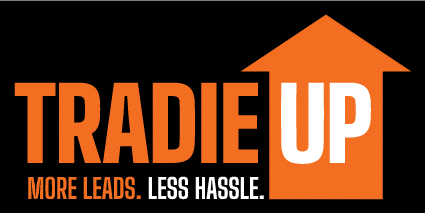Engage Profitable Google Ads For Tradies
Responsive Google Ads For Tradies: Get immediate, high-quality leads that are ready to hire, right now.
• Get immediate, high-quality leads that are ready to hire, right now.
• Maximise your return on investment with cost-efficient, AI-optimised campaigns.
• Pinpoint and capture local customers in your service area with precision targeting.


WHAT DO YOU WANT TO ACHIEVE? INCREASE BRAND AWARENESS INCREASE THE NUMBER OF LEADS INCREASE THE NUMBER OF SALES INCREASE THE VALUE OF SALES DECREASE ADMINISTRATION TIME DECREASE STRESS
Engaging Google Ads For Tradies
Dominate Your Tradie Business with Unbeatable Google Ads
As a trusted Tradie Lead Generation specialist with over 20 years of experience, Tradie Up knows exactly how to apply the power of Google Ads to drive immediate, high-quality leads for your Australian tradie business. Our team of Google Ads experts have perfected the art of connecting Tradies like you with customers actively searching for your services, ensuring every dollar you invest generates a incredible return.
Unlike Google Ads providers, we deeply understand the unique challenges faced by Tradies and how to tailor our Google Ads strategies to your specific needs. We’ll work closely with you to pinpoint your ideal customers, craft compelling ad copy that stops them in their tracks, and use advanced AI-powered optimisation to maximise your return on investment. The result? A predictable and affordable lead management system that increases your sales and saves you time.
Our premium Google Ads service has helped countless Tradies across Australia get immediate, high-quality leads that are ready to hire, right now. We take care of everything – from keyword research and ad creation to bid management and campaign optimisation – so you can focus on doing what you do best: delivering outstanding work for your customers.
But don’t just take our word for it. Our Tradie clients have seen measurable results, including a 47% increase in qualified leads and a 29% reduction in cost per conversion. We’re proud to be a Google Ads Partner, ensuring we always innovate on the topic of best practices, compliance, and delivering exceptional outcomes.
access the Full Potential of Your Tradie Business with Tradie Up
Ready to take your Tradie business to new heights with a laser-focused Google Ads strategy? Our Google Ads experts are standing by to help you achieve a predictable and affordable lead management that increases sales and save time. Alongside our SEO and website services, we’ll ensure your online presence is optimised to capture your ideal customers at every stage of their journey.
Don’t settle for wasted ad spend and unqualified leads. Partner with Tradie Up and experience the difference that true Google Ads expertise can make. Get in touch today to schedule your consultation and discover how we can help you dominate your local market.
Chat With A Tradie Up Google Ads Expert
We are ready to help you with Branding, Websites, SEO, Google Ads, Social Media and Business Automation services, specifically created for tradies.
We increase your brand awareness, get you more enquiries and new customers so that you can scale your business and save you time and reduce stress.
Call Lance on 0449 562 421 at a time that suits you, to see if we are a good fit for your tradie business.
MORE LEADS. LESS HASSLE.
Enquire about Results Driven Tradie Lead Generation
Please leave your details in the form and we will call you back the same day.
So that we can process your enquiry efficiently, please leave as many details as possible.
The Tradie Up Team
Frequently Asked Google Ads Questions By Tradies
Yes, social media is an essential tool for Australian tradie businesses looking to generate tangible leads and ROI. By leveraging Google Ads For Tradies, you can put your services directly in front of customers actively searching for your expertise. This ensures every dollar spent on advertising generates valuable, high-converting leads that translate to real sales.
The Power of Google Ads For Tradies
Google Ads allows you to hyper-target your ideal customers based on their search intent, location, and other key factors. Unlike traditional advertising, you only pay when someone clicks on your ad, making it a cost-effective way to reach new clients. Tradie Up’s AI-driven optimisation ensures your campaigns are constantly refined to maximise your return on investment.
By appearing at the top of Google search results, you establish your business as a trusted authority in your local market. This builds credibility and increases the likelihood of leads converting into paying customers.
Reach out for a no obligation chat about Google Ads For Tradies on 0449 562 421
Tradie Up recommends that Australian tradies primarily focus their social media efforts on Facebook and Instagram to build brand awareness and attract high-quality customers. These platforms offer the most effective reach and engagement for the Tradie Lead Generation industry.
The Power of Facebook for Tradies
Facebook remains the dominant social network in Australia, with over 17 million active users. It allows tradies to showcase their work, share customer testimonials, and engage with their local community. Targeted Facebook ads can also drive immediate, high-intent leads for your services.
Instagram is another essential platform, as it enables tradies to visually showcase their craftsmanship and expertise through compelling imagery and video content. This helps potential customers get a feel for your work and builds trust in your brand.
Reach out for a no obligation chat about Google Ads For Tradies on 0449 562 421
Tradie Up crafts engaging social media content that resonates with your ideal audience and converts them into loyal clients by deeply understanding their psychographics and pain points. Our strategic approach to Google Ads For Tradies ensures we deliver content that speaks directly to your target customers, addressing their specific needs and guiding them towards your services.
Leveraging Psychographics for Targeted Content
We start by analysing your audience’s values, interests, and behaviours to create content that genuinely connects with them. Our team of social media experts and conversion copywriters craft posts, videos, and ads that tap into your customers’ emotional drivers, positioning your business as the trusted solution to their challenges.
By aligning your social media presence with your audience’s psychographics, we build meaningful relationships and foster a sense of brand loyalty, turning followers into loyal, high-value clients for your Tradie business.
Reach out for a no obligation chat about Google Ads For Tradies on 0449 562 421
Absolutely! Social media marketing can be a highly effective way to enhance your tradie brand’s reputation, build trust, and manage your online perception. When done right, social platforms like Facebook, Instagram, and LinkedIn allow you to showcase your expertise, connect with your local community, and demonstrate your commitment to quality workmanship.
Establish Your Authority and Credibility
By consistently posting valuable, informative content on social media, you can position yourself as a trusted expert in your field. Share behind-the-scenes insights, offer practical tips, and highlight your team’s qualifications and experience. This helps potential customers see you as a reliable, knowledgeable provider they can trust with their home improvement or renovation projects.
Social media also enables you to actively manage your online reputation. Respond promptly to customer reviews, address any concerns, and highlight positive feedback. This demonstrates your commitment to customer service and builds confidence in your brand.
Reach out for a no obligation chat about Google Ads For Tradies on 0449 562 421
The time commitment required for social media can vary greatly depending on your business goals and the platforms you choose to focus on. However, at Tradie Up, we understand that as a busy tradie, managing your own social media presence can be a significant drain on your time and resources. That’s why we offer a comprehensive Google Ads for Tradies solution that can fully manage your social media presence for optimal lead generation.
Hassle- Social Media Management
With Tradie Up, you can leave the time-consuming tasks of content creation, posting, and engagement to our team of social media experts. We’ll develop a tailored strategy that aligns with your business objectives and ensures your brand is consistently visible on the platforms that matter most to your target audience. This allows you to focus on what you do best – delivering exceptional service to your clients.
By outsourcing your social media management to Tradie Up, you can up valuable time to concentrate on other important aspects of your business, such as quoting, invoicing, and providing high-quality workmanship. Our team will handle the day-to-day social media activities, freeing you up to do what you love.
Reach out for a no obligation chat about Google Ads For Tradies on 0449 562 421
Tradie Up effortlessly integrates your social media strategies with your SEO, website, and other marketing efforts to create a cohesive lead generation funnel for your Google Ads For Tradies campaigns. By aligning your online presence, we ensure a consistent brand experience that builds trust and drives high-quality leads directly to your business.
Synergistic Digital Marketing Approach
Our team of digital marketing experts work closely with you to develop a tailored strategy that leverages the unique strengths of each channel. We optimise your social media platforms to increase brand awareness, engage your target audience, and funnel qualified leads to your Google Ads campaigns. This integrated approach maximises the impact of your marketing spend and creates a seamless customer journey.
From crafting compelling social content that complements your ads to optimising your website for lead conversion, we take a complete view to deliver measurable results. By unifying your online presence, we establish your authority as a trusted Tradie Lead Generation provider and drive more high-intent customers to your business.
Reach out for a no obligation chat about Google Ads For Tradies on 0449 562 421
The critical social media mistakes Australian tradies commonly make include posting sporadic, low-quality content, failing to engage with their audience, and not leveraging the power of targeted Google Ads for Tradies. Tradie Up helps you avoid these pitfalls by managing your entire Google Ads campaign, from keyword research and ad creation to ongoing optimisation and reporting.
Maximise Your Online Presence and Lead Generation
Our team of Google Ads experts will ensure your business is visible to customers actively searching for your services. We’ll create high-performing ads that showcase your expertise, driving qualified leads directly to your door. With our AI-powered optimisation, we’ll continually refine your campaigns to deliver the best possible return on your ad spend.
By partnering with Tradie Up, you can focus on running your business while we handle the complex world of digital marketing. Our proven strategies will help you stand out from the competition and generate a steady stream of new customers.
Reach out for a no obligation chat about Google Ads For Tradies on 0449 562 421
Tradie Up utilises advanced AI technology to optimise every aspect of our Google Ads campaigns for Australian tradies, from content creation to targeted lead generation. Our AI-powered system analyses search intent, buyer behaviours, and market trends to craft highly engaging ad copy and visuals that capture the attention of customers actively seeking your services. This data-driven approach ensures your Google Ads deliver a steady stream of qualified leads that convert into sales, maximising your return on investment.
AI-Powered Content Optimisation
Our AI assistant automatically generates ad copy and creative that speak directly to your target audience. It identifies the most effective keywords, messaging, and visuals to grab attention and drive click-throughs. This frees you up to focus on running your business, while we handle the complex task of creating high-performing Google Ads campaigns.
The AI also continually monitors campaign performance, making real-time adjustments to optimise for maximum conversions. This allows us to rapidly scale successful ads and pause underperforming ones, ensuring your marketing budget is always working hard for you.
Reach out for a no obligation chat about Google Ads For Tradies on 0449 562 421
When you invest in a professional social media marketing strategy with Tradie Up, you can expect a measurable return on investment (ROI) through our Google Ads For Tradies service. Our data-driven approach ensures that every dollar spent on your Google Ads campaign generates valuable, high-converting leads for your business.
Maximise Your ROI with Tradie Up’s Google Ads Expertise
Our team of Google Ads specialists will work closely with you to develop a tailored campaign that targets customers actively searching for your services. By leveraging advanced AI-driven optimisation, we’ll continuously refine your ads to achieve the highest possible conversion rates, delivering an exceptional ROI that far exceeds what you could achieve on your own.
Unlike Google Ads providers, Tradie Up has a deep understanding of the Australian tradie industry. We’ll help you navigate the complexities of Google Ads, ensuring your campaign is compliant with local regulations and aligns with the unique needs of your target market.
Reach out for a no obligation chat about Google Ads For Tradies on 0449 562 421
Beyond likes and shares, Tradie Up ensures your social media presence directly translates into booked and sustainable business growth through our targeted Google Ads for Tradies campaigns. By leveraging data-driven insights and AI-powered optimisation, we put your services in front of customers actively searching for your offerings, driving immediate, high-converting leads that grow your bottom line.
Proven Strategies for Measurable Results
Our Google Ads specialists analyse your target audience, competitor landscape, and industry trends to craft tailored campaigns that outperform efforts. We handle the entire process – from keyword research and ad copywriting to bid management and performance tracking – ensuring your marketing budget is transformed into a reliable stream of qualified leads.
By combining our expertise in search engine marketing with Tradie Up’s unparalleled understanding of the local trades industry, we deliver campaigns that consistently generate tangible business growth, not just vanity metrics. Our data-driven approach allows us to continually refine and optimise your ads, maximising your return on investment.
Reach out for a no obligation chat about Google Ads For Tradies on 0449 562 421
Need Some Professional Digital Marketing Advice For Your Tradie Business?
We understand you are great at your trade and maybe digital marketing isn’t your thing, that’s okay. Let’s have a chat and see what would suit you best.
